Emily Tucker
@emilyltucker.bsky.social
600 followers
570 following
84 posts
Industrial Engineer and Operations Researcher • Assistant Professor at Clemson • Christian • Improving Access to Social Good in Systems Under Strain
Posts
Media
Videos
Starter Packs
Emily Tucker
@emilyltucker.bsky.social
· Jun 20

Developing optimization models with cognitive systems engineering
One goal of applied operations research is to improve decisions in practice. For an optimization model to be useful, the underlying problem must be understood, the formulation representative, the d...
www.tandfonline.com
Emily Tucker
@emilyltucker.bsky.social
· May 28
Emily Tucker
@emilyltucker.bsky.social
· May 28

Effects of geopolitical strain on global pharmaceutical supply chain design and drug shortages
Emerging geopolitical risks have begun to threaten global supply chains, including those that produce life-saving drugs. Export bans may prevent a com…
www.sciencedirect.com
Emily Tucker
@emilyltucker.bsky.social
· May 27
Reposted by Emily Tucker
Emily Tucker
@emilyltucker.bsky.social
· Apr 30
Reposted by Emily Tucker
χle Ormsby
@motivickyle.bsky.social
· Mar 11
Emily Tucker
@emilyltucker.bsky.social
· Feb 25



















